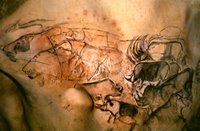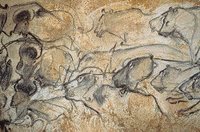 I'm reading this book by Victoria Finlay, called "Color, A Natural History of the Palette". She travels around the world researching all the pigments that make up an artist's palette. Nowadays, all you have to do is go to the shop and buy tubes of oil paint, acrylics or watercolours. But the old masters didn't have it so easy.
I'm reading this book by Victoria Finlay, called "Color, A Natural History of the Palette". She travels around the world researching all the pigments that make up an artist's palette. Nowadays, all you have to do is go to the shop and buy tubes of oil paint, acrylics or watercolours. But the old masters didn't have it so easy.If you saw the movie "Girl with a Pearl Earring", you will remember that Johannes Vermeer, or his assistant - in the movie, the lovely Scarlett Johansson - had to grind stones into powders to make up his paints.
She has a chapter on each colour, and tells her stories well. It's a pity that the book doesn't have that many pictures in it, but you can always search the images on Google. In a way, you get to make your own journey to discover the colours that way.
She talks about the importance of ochre for the aboriginals in Australia, about the search for the perfect steadfast red, about the poisonous effect of lead in white paint, etc..
 In her chapter on Black, she talks about the use of charcoal in the earliest paintings discovered in Europe - in the Chauvet Cave in the Ardèche Valley in France. These were discovered in 1994, and the paintings have been dated to be 30,000 years old! Twice as old as the Lascaux paintings! I don't think any of my drawings and paintings will last that long -unless I start drawing in charcoal!
In her chapter on Black, she talks about the use of charcoal in the earliest paintings discovered in Europe - in the Chauvet Cave in the Ardèche Valley in France. These were discovered in 1994, and the paintings have been dated to be 30,000 years old! Twice as old as the Lascaux paintings! I don't think any of my drawings and paintings will last that long -unless I start drawing in charcoal! The Chauvet cave paintings cover 10 metres on one wall - there are a dozens lions, rhinoceroses, bison, mammoths, a reindeer...
The Chauvet cave paintings cover 10 metres on one wall - there are a dozens lions, rhinoceroses, bison, mammoths, a reindeer...Even just reading about it, you feel the excitement of the discovery: "In one place four horses seem to rear up, ready to gallop; their heads are skillfully shadowed in charcoal while their bodies are just sketched roughly. This tendency to concentrate on the fronts of the animals gives the sense not just of movement but of stampede"

No comments:
Post a Comment